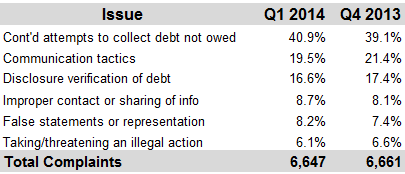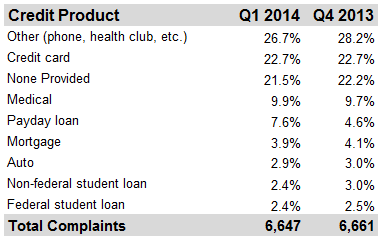In the first quarter of 2014, the percentage of consumers that filed complaints against debt collectors claiming that the debt in question was not theirs increased to more than 40 percent of all complaints.
Overall, the number of debt collection complaints in the first quarter of 2014 were flat compared to Q4 2013, with 6,647 logged this year, and 6,661 reported in the final three months of last year. The Consumer Financial Protection Bureau’s consumer complaints database currently includes debt collection complaints only through March 17, 2014, so the numbers are likely to change slightly.
When filing a debt collection complaint, consumers are asked to select the reason for their complaints from a pre-set list of issues. For the first quarter, the most commonly-cited issue in debt collection complaints was “Continued attempts to collect debt not owed,” constituting almost 41 percent of complaints, compared to 39 percent in the fourth quarter of 2013.
 The second most common issue was the broad “Communication tactics” cited by 19.5 percent of consumers in Q2 2014, down from 21.4 percent in Q4 2013.
The second most common issue was the broad “Communication tactics” cited by 19.5 percent of consumers in Q2 2014, down from 21.4 percent in Q4 2013.
There was also some movement in the “Sub-product” complaint category, the field used to distinguish what type of debt underlies the complaint. The most commonly-cited sub-product is the CFPB’s “Other” category, accounting for 26.7 percent of all complaints. But this category will change over time as the CFPB’s Consumer Response unit adds more debt types to the choices given to consumers.
 This was borne out in the first quarter statistics as the Payday Loan category recorded a significant increase, from 4.6 percent of all complaints in Q4 2013 to 7.6 percent in Q1 2014. The CFPB added Payday Loan as an option in early November last year, so the fourth quarter numbers were skewed lower. Since that option was available for all of Q1 2014, the 7.6 percent figure is probably closer to accurate.
This was borne out in the first quarter statistics as the Payday Loan category recorded a significant increase, from 4.6 percent of all complaints in Q4 2013 to 7.6 percent in Q1 2014. The CFPB added Payday Loan as an option in early November last year, so the fourth quarter numbers were skewed lower. Since that option was available for all of Q1 2014, the 7.6 percent figure is probably closer to accurate.
Tomorrow, we’ll look at what type of ARM company the complaints were logged against.




![the word regulation in a stylized dictionary [Image by creator from ]](/media/images/Credit_Report_Disputes.max-80x80.png)
![Cover image for New Agent Onboarding Manuals resource [Image by creator from insideARM]](/media/images/New_Agent_Onboarding_Manuals.max-80x80_3iYA1XV.png)


![[Image by creator from ]](/media/images/New_site_WPWebinar_covers_800_x_800_px.max-80x80.png)
![[Image by creator from ]](/media/images/Finvi_Tech_Trends_Whitepaper.max-80x80.png)
![[Image by creator from ]](/media/images/Collections_Staffing_Full_Cover_Thumbnail.max-80x80.jpg)
![Report cover reads One Conversation Multiple Channels AI-powered Multichannel Outreach from Skit.ai [Image by creator from ]](/media/images/Skit.ai_Landing_Page__Whitepaper_.max-80x80.png)
![Report cover reads Bad Debt Rising New ebook Finvi [Image by creator from ]](/media/images/Finvi_Bad_Debt_Rising_WP.max-80x80.png)
![Report cover reads Seizing the Opportunity in Uncertain Times: The Third-Party Collections Industry in 2023 by TransUnion, prepared by datos insights [Image by creator from ]](/media/images/TU_Survey_Report_12-23_Cover.max-80x80.png)
![Webinar graphic reads RA Compliance Corner - Managing the Mental Strain of Compliance 12-4-24 2pm ET [Image by creator from ]](/media/images/12.4.24_RA_Webinar_Landing_Page.max-80x80.png)